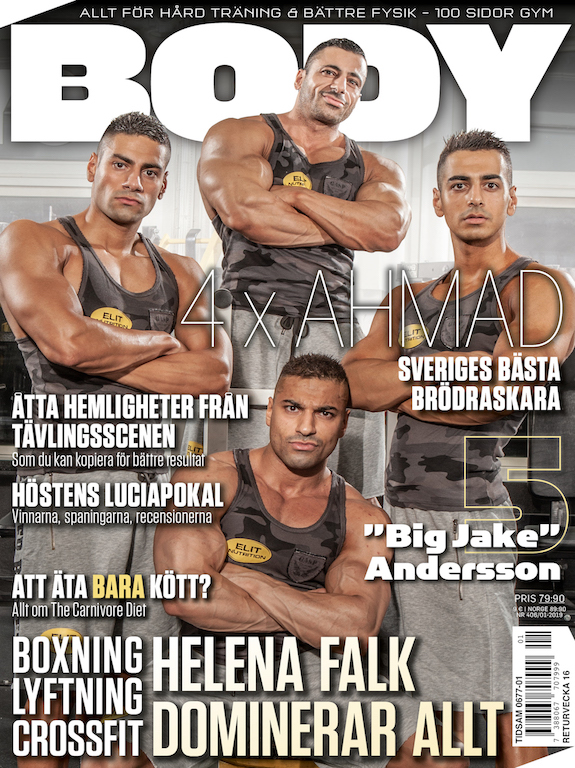Home › Forums › Styrkehörnan › Teknik i knäböj?
- This topic is empty.
-
AuthorPosts
-
5 november, 2006 at 19:43 #948552
Anonym anvandare
MemberHejsan, ledsen att jag stör. Bara undrar en sak, jag tyckre knäböj verkar vara ne grym övning, men jag klarar inte den själv, det blir vingligt och osäkert och det känns som stången ska ramla av. Läskigt. Ska man vara helt rak i ryggen när man gör knäböj och sedan gå ner till huksittande och upp igen? Jag ser ibland folk som bara går ner nån decimeter, det verkar inte så bra? Fan jag vill kunna knäböj, men får bara ont i knäna och det blir vingligt och kasst. Finns det nån bra teknik?
5 november, 2006 at 19:43 #89065Anonym anvandare
Member5 november, 2006 at 20:06 #948553Anonym anvandare
Member[http://www.kolozzeum.com/forum/showthread.php?t=11027] del 1
[http://www.kolozzeum.com/forum/showthread.php?t=11993] del 2
[http://www.geocities.com/~slopitch/drsquat/fredsq.htm]
kanske kan hjälpa lite
5 november, 2006 at 20:39 #948554Anonym anvandare
MemberTackar, det är bra. Räcker så. Undrar bara varför jag får ont i knäna.
5 november, 2006 at 21:50 #948555Anonym anvandare
Memberbubbas wrote:Kör inte då, vila istället!Det verkar vara en bra övning, men jag kanske ska hålla mig till andra benövningar då?
5 november, 2006 at 22:25 #948556Anonym anvandare
Memberom du får ont i knäna handlar det om att du sätter dig framåt och låter knäna i bottenläget vara framför tårna. knäböj handlar om att sätta sig bakåt. bästa sättet att öva upp knäböj samt bygga rätt styrkesaker i knäböj är att köra box squats.
antingen på en box eller en bänk som är 25cm hög.
när man kör böj ska höften starta rörelsen INTE knäna. du ska stå axelbrett. knäna ska jobbai sidled. du ska vilja dra i sär golvet med fötterna kan man säga när du jobbar.
följ denna text så kan det inte misslyckas. box squats är GRYMMA
Introducing the Box Squat
________________________________________
Squatting from Head to Toe
Introducing the Box Squat
by Dave TateDave Tate knows strength. Dave’s been assisting and training under Louie Simmons of Westside Barbell fame for over 10 years and has consulted thousands of athletes throughout the world. Dave is quick to point out that he’s not a bodybuilder and therefore doesn’t train bodybuilders. He’s a powerlifter and a specialist in developing maximal strength. (Despite this powerlifting emphasis, the average guy under his tutelage puts on 30 to 40 pounds a year.)
In Dave’s last article he taught us the secrets of a big bench. This time, Dave has written the definitive article on the infamous Westside box squat. Does he know what he’s talking about? He squats 935 pounds himself, what do you think?
The Box Squat
Technique is the most important factor in squatting big weights. If you’re training with bad technique then it doesn’t matter what supplemental exercises you use or how many sets or reps you perform. Your squat will only go so far and then get stuck. This article will describe the correct technique for performing the box squat. I feel the box squat is the best way to train the squat, period. The form is the same as the regular squat but with the added bonus of being able to develop explosive strength. The box squat also places all the stress directly on all the squatting muscles.
Every member of Westside Barbell performs box squats year around with the only regular ”free squat” being done in competition. The technique I’ll describe has taken my squat from 760 to 935 over the past five years, but I wasn’t always a big fan of the box squat. When I squatted 760, I didn’t believe in box squatting and trained all my squats the same way many of you are doing now. I used a progressive overload method using the Western method of periodization. The result of all my hard work? My squat stayed at the 730 to 760 range for five years without any progress! I had to change. Part of this change included box squatting.
The use of the box squat made a tremendous difference in my progress and the progress of my training partners. Every one of us added 100 to 200 pounds to our max efforts after adopting the box squat. We also understood the importance of perfecting the box squat to get a big carryover in competition. We check each other’s form on a constant basis and the things we look for will be detailed in this article.
Now, you may have heard from some sissy wearing spandex that the box squat is dangerous. When someone talks about the dangers of box squatting, it’s apparent they simply don’t know how to perform the lift correctly. Sure, if you’re trying to bounce off the box or you’re using more weight than you can handle, then there are definitely dangers to the spine. When performed correctly, however, box squats are safe. And, I believe box squats are so effective that you don’t need to perform regular squats in your training at all!
Advantages of Box Squatting
There are many advantages to box squatting:
1) Training on a box will allow you to sit back onto the box to a point where your shins are past perpendicular to the floor. This places all the stress on the squatting muscles (hips, glutes, lower back and hamstrings.) When you can increase the stress on these muscles and lower the stress on the quads, then you’ll be ready to see your squat poundages start moving.
2) Restoration is another major advantage of box squatting. You can train more often on a box when compared to free squatting. According to Louie Simmons, the original members of Westside Barbell in Culver City, California, used to perform box squats three times a week. Currently at Westside we train the box squat every Friday for our dynamic workout and occasionally on Monday’s maximal effort workouts. If you’re new to box squats, I suggest you do them once per week.
Louie Simmons, doing what he does best.
3) When performing box squats you never have to guess how low you’re squatting. It’ll always be the same. Think about it: when most people start adding weight to the bar, their squats get higher and higher. You see this all the time in any gym you go to. They look good with the light weights, then begin doing quarter squats when the weight gets heavy. With box squats, you’ll always go low enough.
4) The last reason to box squat is to reinforce good squat technique. Many times for the intermediate or beginning squatter, the hamstrings aren’t yet developed and ”sitting back” into a squat is impossible without falling over backward. To teach these athletes how to free squat properly would take months. The squat wouldn’t look right until the hamstrings and glute strength increases. Why wait two or three months? Put them on the box and you’ll have them squatting properly within five minutes. Within one month the hamstrings will begin to kick in because of the added stress of sitting back on the box.
The Details
Now, are you ready to box squat? Good.
Phase I: The first thing to check for is proper body position at the beginning of the lift. Keep in mind you’ll have to keep the entire body tight. If any body part is held loose it will become your weak link and you’ll break down.
Before setting up under the bar you’ll need to grasp the barbell and duck under it with your feet about shoulder width apart or slightly wider. While under the bar you’ll have to start to really tighten up. Grasp the bar with your hands and start to squeeze it as if you were trying to bend the bar across your back. Next, pull your shoulder blades together as tight as possible while pulling your elbows forward. This is to keep the upper back locked in this position during the lift. If your elbows are flaring out, it’ll cause the barbell to travel forward at some point during the lift. The key to squatting big weights is to keep the barbell path traveling in the shortest line as possible. Any deviation from this line will cause a missed lift.
Now that your upper back is tight you’ll need to tighten your midsection. First, expand your abdomen as much as possible. When you pull air into your body it should be into the diaphragm, not the chest. Expand you belly and push it out against your belt. This will stabilize and support the lower back and not elongate the spine. If you’re having a hard time trying to figure this out, then wear your weight belt one notch loose and push into it with your belly so it becomes tight.
Pushing your belly out goes against what many believe because they feel training this way will cause injuries to the lower back. After 30 years of box squatting Westside has had 23 lifters squat over 800 pounds, six over 900 pounds and one over a grand. Not one of these lifters or any of the others has had lower back problems.
Another aspect of this to keep in mind is the circumference of the waist line. If I suck my belly in my waist line measures 42 inches. If I pull air into my belly and push it out it measures 48 inches. The wider base the stronger the lifter. This is why lifters with a bigger waist squat more. The pyramids in Egypt are also built with a wide base and they have been standing for centuries. As the car commercials used to say, wider is better.
I learned this lesson firsthand at the 1990 Toledo Hall of Fame powerlifting competition. I’d just tried a 760 squat and got smashed with it. This was my second attempt of the day and I decided to give it another try on the third. I had some doubts because the second attempt wasn’t even close. Saying I got smashed is an understatement. The weight stapled me to the floor! I didn’t even get out of the bottom of the lift. This weight was a 20 pound personal record for which I had spent the last four months training.
I didn’t understand what the problem was or how to fix it. On the third attempt, while I was getting wrapped, Louie Simmons walked up to me and told me to get my abdominals tight. I had no idea what he was talking about at the time, but would within the next few minutes. As I got under the weight I realized Louie was the spotter behind me. (No pressure there, huh?) As I got set under the bar he told me to expand and push my belly into the belt. Now I understood what he was talking about. I was always told to flex my abs, but never to expand and push out.
As I set the bar up, I noticed that I had never felt so tight and stable. Once set, I locked in my back and began the squat. I kept my belly pushed into the belt and blasted the weight up! I had just smoked a weight that stapled me to the floor moments earlier all because I learned how to use my abdominals! In my opinion, this concept is one of the most misunderstood in the sport of powerlifting today. Many lifters don’t know how to use their core to set up a squat. Some do nothing at all while others are trying to suck their stomachs in. This is probably fine for those who strive to squat 400 pounds, but if you’re looking to squat maximal weights in the 700 to 900 range, you’d better learn how to use your core.
All the power of the lower body is transferred through your core to the barbell. If this core isn’t tight the power will ”get lost” so to speak and never travel to the bar. While I don’t agree with the use of a belt for the majority of training, I do believe in the use of belts to teach a person how to use the abdominals while squatting. The belt is a training aid in competition, so you must learn how to use it to its fullest advantage.
Phase II: Now that you have your upper back and belly tight, you need to arch the bar out of the rack. When you take a barbell out of the rack, it should never hit the front supports. This shifts the weight to the toes and will cause you to lose your tightness (as well as set the bar in a position to use your quads instead of your hips and hamstrings.)
Arch the bar out, then push with your legs to get the bar off the racks. Keep the arch. Step back with one leg, then the other. You want to maintain your tightness and set your stance as wide as possible. I believe in using a wide stance when squatting because it’ll shorten the distance the bar will have to travel and will place the stress more on the glutes, hips, hamstrings and back. I’ve figured out over time that the quads aren’t that important for squatting maximal weights. Instead, it’s the hips, back and hamstrings. If your quads were really doing all the work, then why wouldn’t you be able to squat as much as you could leg press? So, set up in a wide stance.
From this position, pull all the air back into your belly and try to make your back and abs tighter than before. You should also be forcing your knees out to the sides. You’ll know you’re doing this right if your hips feel tight. This will place the stress on the hips as well as increase the leverage in the bottom of the squat. The closer you can keep your knee, ankle, shoulder and hip joints in a straight line, the greater the mechanical advantage. This is why you can quarter squat much more than you can full squat.
You also want to be pushing out on the sides of your shoes. Never push downward. Act as if you’re tying to spread the floor apart. This is to further activate the hips. By the way, the best shoes to wear while squatting are the old school Converse Chuck Taylors. They’re built with a flat bottom and strong canvas sides. Most other tennis shoes will cause your foot to move around too much or you’ll push out over the side of the shoes.
Your butt should also be sticking out with your back arched as hard as possible. Head position is vital to keeping the barbell in the proper path for squatting. You must drive your head into the bar. This doesn’t mean look up; you should actually be looking forward. You want to be looking forward for a couple of reasons. First, if you’re in a competition, you’ll need to see the head judge give you the squat signal. Second, you’ll want to see everyone’s reaction after you smoke your lift! I don’t know about you, but I want to see the look of awe in their eyes after I get the lift.
Besides, if you’re looking down you’ll more than likely start to fall forward about half way up and miss the lift. The act of pushing your head back into the neck should be the same action as if you were to lay on the floor and push your head against the ground. As for toe position, lighter guys should usually point their toes straight ahead. Heavier guys, often because of a lack of flexibility, may want to point their toes out slightly. Now you’re ready to begin the squat.
Phase III: To start the squat, I want your hips to begin the motion, not the knees. When your knees bend first, the load is shifted downward; you need the load going backward. Remember, you want the bar to travel in a straight line. Keep pushing the hips back as you squat down. The key is to ”sit back.” Most people sit down on a toilet with better form than they squat because they have to sit back. As you sit back you want to feel tension in the hamstrings. Act like they’re springs you’re trying to compact before they rebound back. This will cause a great stretch reflex out of the bottom of the squat. An explosive start is another key to squatting maximal weights.
Keep sitting back until you sit on the box. The box should be one inch lower than parallel for most people, although I sometimes recommend that less experienced lifters find a box that puts them at one inch above parallel. (Note: I can’t recommend a pre-manufactured box at this time because I simply haven’t found any good ones. All of our boxes at Westside are homemade. When selecting a box, most people need one between 12 and 14 inches high. Also, pick one that’s big enough to fit your butt. Note that some people use a flat bench for box squats. I’ve found that these are seldom set at the proper height, however, and may be too narrow for some.)
As far as the definition of ”parallel,” it’s defined as when the crease of the hip is in line with the top of the knee. Remember, most people have very poor hamstring and hip strength to squat properly in the first place. If they tried to squat without the box they’d fall over backward. The box is the best way to teach proper squat form while bringing up their weak points. The box squat also breaks the eccentric/concentric chain. This is one of the best ways to build explosive strength. The box squat also causes you to squat from a static contraction to a dynamic concentric contraction, another very effective way to build explosive strength.
When you reach the box you want to sit down and relax the hips flexors while keeping every muscle other muscle tight. You also don’t want to fall down on the box and try to bounce off of it. You sit back with the same speed you squat. Pause on the box for a split second and explode off of it. No bouncing! Your knees must still be pushed out and your abs, upper back and arms should remain tight while your back stays arched. When you’re on the box it’s important to have the shins perpendicular to the floor or better yet, past perpendicular. This places all the tension on the squatting muscles.
Phase IV: After you pause on the box you need to explode off by first driving the head and upper back into the bar, then by driving with the hips. When you begin the squat (during the eccentric phase) the hips move first then the head. The opposite of that (the concentric phase) should involve the head moving first then the glutes. It only makes sence to try to lift the bar first. If you don’t drive with the upper back first then the bar will begin to move forward. If the bar is moving forward before you drive with the hips, you’ll miss the weight and fall forward.
As you’re coming up you still need to maintain all tightness by driving your back into the bar, driving you head into the bar, pushing out on your knees and feet, pulling the elbows forward, keeping the shoulder blades together, and holding your air. After that there’s nothing else to do but lock out and wait for the crowd to cheer.
That’s all there is to it. And they say squatting isn’t a technical lift! Now it’s up to you. Do you want to be standing there watching others lift the big weights, or on the platform doing it yourself? You decide.
6 november, 2006 at 10:10 #948557Anonym anvandare
MemberTack så mycket. Det ska jag följa. Det är väl därför jag har fått ont då. Tänk vad mycket småfel man gör som kan bli stor. Återigen: Tack.
6 november, 2006 at 16:50 #948558Anonym anvandare
MemberAlex: Grymt bra text, mkt illustrerande. Länk? Skulle vilja ha liknande text för övriga sl-övn.
6 november, 2006 at 18:22 #948559Anonym anvandare
Memberska se om jag kan hitta några mer länkar. återkommer sen i kväll

här är en bild på hur bottenläget ska se ut i böj.:
själva linjen man ska gå efter på djup är den där höft går under knä.6 november, 2006 at 18:36 #948560Anonym anvandare
MemberAhaa, man FÅR ha ryggen såpass mycket böjt? Då fattar jag, jag har alltid försökt vara i 90 graders vinkel. Men efter alla de här inläggen börjar det klarna. Bara att sätta igång och praktisera det hela. Tror inte jag ska gå ner ändå till hu k heller för då får jag mer ont. Börja försiktigt.
6 november, 2006 at 19:41 #948561Anonym anvandare
MemberAlex Thunholm wrote:ska se om jag kan hitta några mer länkar. återkommer sen i kväll
här är en bild på hur bottenläget ska se ut i böj.:
själva linjen man ska gå efter på djup är den där höft går under knä.Jag är mycket mer upprät i ryggen än sådär i ryggen. Är det där godkända SL lyft?
6 november, 2006 at 20:33 #948562Anonym anvandare
MemberDavidN wrote:Jag är mycket mer upprät i ryggen än sådär i ryggen. Är det där godkända SL lyft?ja självklart.
finns nästan ingen som kan ha upprätt rygg med mkt vikt på axlarna. kanske om man är kort. elller har en kort överkropp.
måste ju liksom ha en lutning på överkroppen då stången ska ligga nedanför trapzen. och man ska ned under 90 grader annars ramlar den ju bara i golvet.
6 november, 2006 at 20:46 #948563Anonym anvandare
Memberen som jag hitta om bänkpress:
[http://www.criticalbench.com/benchpress-101.htm http://www.criticalbench.com/benchpress-101.htm%5D
finns massa andra artiklar där med på sidan om allt möjligt.
6 november, 2006 at 20:50 #948564Anonym anvandare
MemberJo, jag har extrem spänning i axlarna för att upprätthålla min rygglinje hela vägen till ATG
6 november, 2006 at 20:53 #948565Anonym anvandare
MemberHåller helt med Alex Thunholm. Det som beskrivs i tråden där dock SL-knäböj. Tyngdlyftare kör på ett annorlunda sätt. Personligen tycker jag att deras knäböj är mycket snyggare än knäböj såsom vi styrkelyftare utför dem.
[youtube=2jr1FuaoDco]
[youtube=AH-IadDDsK4]
[youtube=cu4v-USn0DE]
[youtube=C0yrvG9t4iw]
Dessa killar är de mest imponerande styrkeatleterna som finns.
-
AuthorPosts
- You must be logged in to reply to this topic.






